John Taylor was an English publisher, essayist, and writer. He is noted as the publisher of the poets John Keats and John Clare.

The American Peace Society is a pacifist group founded upon the initiative of William Ladd, in New York City, May 8, 1828. It was formed by the merging of many state and local societies, from New York, Maine, New Hampshire, and Massachusetts, of which the oldest, the New York Peace Society, dated from 1815. Ladd was an advocate of a "Congress and High Court of Nations." The society organized peace conferences and regularly published a periodical entitled Advocate of Peace. The Society was only opposed to wars between nation states; it did not oppose the American Civil War, regarding the Union's war as a "police action" against the "criminals" of the Confederacy. Its most famous leader was Benjamin Franklin Trueblood (1847–1916), a Quaker who in his book The Federation of the World (1899) called for the establishment of an international state to bring about lasting peace in the world. In 1834 the headquarters of the society were removed to Hartford, in 1834 to Boston, Massachusetts, in 1911 to Washington, D.C. The group is now based in Washington. Its official journal is World Affairs.
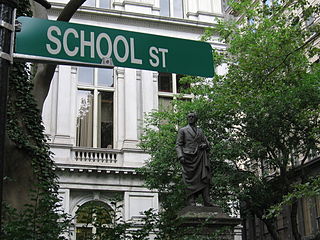
School Street is a short but significant street in the center of Boston, Massachusetts. It is so named for being the site of the first public school in the United States. The school operated at various addresses on the street from 1704 to 1844.

Oliver Ditson was an American businessman and founder of Oliver Ditson and Company, one of the major music publishing houses of the late 19th century.
The Boston Almanac was an almanac and business directory in 19th century Boston, Massachusetts. Its offices were destroyed in the Great Boston Fire of 1872. The first almanac was published in 1836, and continued annually until at least 1894. Just about all editions contained a chronology of major events in Boston for the previous year or two years. Each almanac contained business listings, advertisements, and often city and/or state department information. Railroad, omnibus, and horse car companies were usually listed in a separate section. Some volumes highlighted famous buildings or places.

William Pembroke Fetridge (1827-1896) was a travel writer, publisher, bookseller and periodicals distributor. He lived in the Boston, Massachusetts area and in Paris, France.
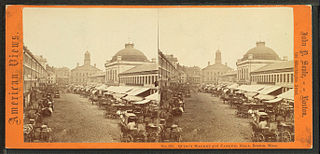
John Payson Soule (1828–1904) was a photographer and publisher in Boston, Massachusetts, and Seattle, Washington.
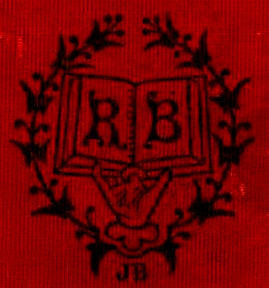
Messrs. Roberts Brothers (1857–1898) were bookbinders and publishers in 19th-century Boston, Massachusetts. Established in 1857 by Austin J. Roberts, John F. Roberts, and Lewis A. Roberts, the firm began publishing around the early 1860s. American authors included: Louisa May Alcott, Susan Coolidge, Emily Dickinson, Maud Howe Elliott, Louise Imogen Guiney, Julia Ward Howe, Helen Hunt Jackson, Abigail May Alcott Nieriker. British and European authors included: Berthold Auerbach, Caroline Bauer, Mathilde Blind, Juliana Horatia Ewing, Anne Gilchrist, David Gray, Philip Gilbert Hamerton, Jean Ingelow, Vernon Lee, William Morris, Silvio Pellico, Adelaide Ristori, A. Mary F. Robinson, George Sand, Charlotte Mary Yonge, Helen Zimmern.

Lee & Shepard (1862-1905) was a publishing and bookselling firm in Boston, Massachusetts, in the 19th century, established by William Lee (1826–1906) and Charles Augustus Billings Shepard (1829–1889) Authors published by the firm included: George Melville Baker; Sophie May; Henry Morgan; Oliver Optic; William Carey Richards; Francis Henry Underwood; Madeline Leslie and Levina Buoncuore Urbino. The business conducted its operations from offices at 149 Washington St. (ca.1872); the corner of Franklin and Hawley St. (1873–1885); and "adjoining the Old South," no.10 Milk St. (ca.1885).

The Boston True Flag (1851-1908) or True Flag was a weekly fiction periodical published in Boston, Massachusetts, in the 19th century. Contributors included Francis A. Corey, Susan E. Dickinson, Fanny Fern, Louise Chandler Moulton, Oliver Optic, and John Townsend Trowbridge. Publishers William U. Moulton, J. R. Elliott, Martin V. Lincoln, and J. W. Nichols produced the paper from offices on School Street, Bromfield Street, and Arch Street.
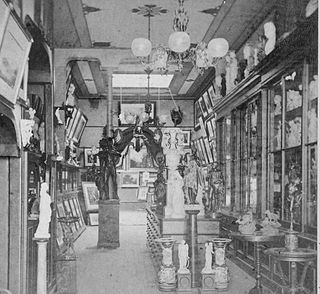
De Vries, Ibarra & Co. were "importers of paintings, engravings, bronzes, and works of art in general," "publishers of busts and statuary," and "importers and publishers of books in foreign languages." Based in Boston, Massachusetts, in the 1860s the firm kept a shop in the Albion Hotel building on Beacon Street, and later on Tremont Street. Proprietors included Guy Horvath De Vries and Mrs. De Vries. Staff included Carl Schoenhof, who bought the firm in 1870.
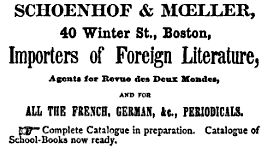
Carl Schoenhof was a bookseller and publisher in Boston, Massachusetts, in the 19th century. He specialized in foreign books. Born in Carlsruhe, Germany, he attended University of Heidelberg. He moved to the U. States around 1864. Shortly thereafter he worked for Boston publishers DeVries, Ibarra & Co., and took over the business in 1870. His business ventures included Schoenhof & Moeller, Cupples & Schoenhof, and Schoenhof Book Co. (ca.1890s).
Levina Buoncuore Urbino or Lavinia Buoncuore Urbino was an American writer and translator who lived in the Boston, Massachusetts area in the 19th century. Among her published works was An American Woman in Europe (1869), a frank account of her travels in Europe 1866-1869; she also wrote children's books and a guide to art technique. She sometimes wrote under a pseudonym: L. Boncoeur, L. B. Cuore, or L. Buoncuore.
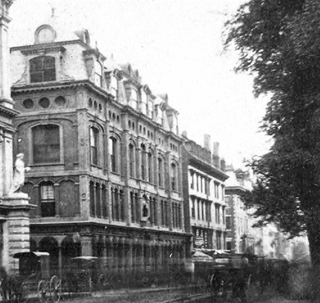
The Studio Building (1861–1906) on Tremont Street in Boston, Massachusetts, housed artists' studios, theater companies and other businesses in the 19th century. It "held the true Bohemia of Boston, where artists and literati delighted to gather." Among the tenants were portraitist E.T. Billings, architect George Snell, sculptor Martin Milmore, artists William Morris Hunt, William Rimmer, Edward Mitchell Bannister, Phoebe Jenks; gallerist Seth Morton Vose, and many others.

Edwin Tryon Billings (1824-1893) or E.T. Billings was a portrait painter in 19th-century United States. He lived in Montgomery, Alabama; Worcester, Massachusetts; and in Boston. Among his numerous portrait subjects were Daniel Webster, William Lloyd Garrison and Oliver Wendell Holmes, Sr.
Nathaniel Stone Simpkins was a bookseller, publisher, and legislator in Massachusetts in the 19th century. He ran a bookshop and circulating library in Boston ca.1820-1830. "In 1835 he established the Barnstable Journal [of Barnstable, Massachusetts], and in 1856 he established the Yarmouth Register" of Yarmouth, Massachusetts. Simpkins served as a "Representative to the General Court of Mass. in 1836, 1850 and 1851."
Louis Pierre Goullaud published and sold music in Boston, Massachusetts, in the 19th century. In the 1860s he worked for "Koppitz, Pruefer & Co." With Asa Warren White (1826–1894) and his son, Edward Warren White (1849–1896) – as the firm "White & Goullaud" – he sold musical instruments and published sheet music. Under his own imprint he issued sheet music and Goullaud's Monthly Journal of Music. He retired c. 1886, and died in Braintree on December 7, 1919.

Bela Marsh (1797-1869) was a publisher and bookseller in Boston, Massachusetts, in the 19th century. Authors under his imprint included spiritualists and abolitionists such as John Stowell Adams, Adin Ballou, Warren Chase, Lysander Spooner, and Henry Clarke Wright. Marsh kept offices on Washington Street (ca.1820-1832), Cornhill (ca.1847-1852), Franklin Street (ca.1854-1856), and Bromfield Street (ca.1858-1868). Among his business partners were Nahum Capen, Gardner P. Lyon, T.H. Webb, and George W. Williams. He belonged to the Massachusetts Charitable Mechanic Association and the Physiological Society.

Thomas Rice Burnham (1834-1893) or T.R. Burnham was an American photographer. In the 1860s he worked in Maine with Asa Marsh Burnham as "Burnham Bros." He later moved to Boston, Massachusetts and operated from a studio on Washington Street until at least 1885. He belonged to the Boston Photographic Society and/or Boston Association of Photographers; among his contemporaries were J.W. Black, E.J. Foss, and E.F. Smith. Portrait subjects included Edwin Booth, Alvan Clark & Sons, Edw M Endicott, Clement Granch, Ulysses S. Grant, William Stevens Perry, George Antony Smalley, and Nathan and Mary Barrett Warren. Burnham showed photos in the 1876 Philadelphia Centennial Exposition and the 1887 exhibition of the Massachusetts Charitable Mechanic Association.















